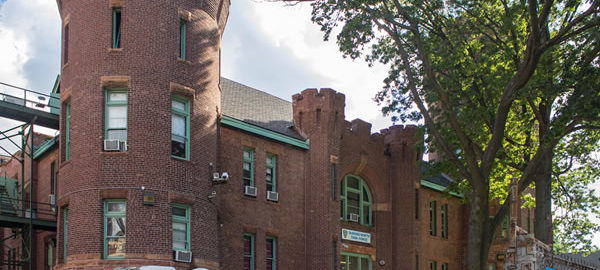![[Flushing Highlights] IMG_1223 [9/9/2012 4:15:03 PM]](https://www.newyorkitecture.com/wp-content/uploads/2012/09/IMG_1223_resize-220x220.jpg)
Now an enclave of Korean and Chinese immigrants, Flushing was originally settled by the Dutch in the 1600s and remained an independent town until 1898, when Queens became a borough of New York City.
Among other distinctions, Flushing claims to be the birthplace of religious freedom in the United States. The Society of Friends (Quakers) had been outlawed; John Bowne was arrested for permitting Quakers to meet in his house (pictured in this gallery). Upon appeal to the Dutch government, Bowne was acquitted – establishing freedom of worship.
The most modern landmark, the RKO Keith’s Theater, is due to be replaced by a 17-story rental apartment building. Plans are to incorporate the landmark-designated theater lobby within the new structure.
Within a three-block radius are 10 buildings of architectural and historical interest (including the Queens Historical Society). And if you should get hungry while exploring the area, you just might find a Chinese or Korean restaurant or two….
Other Resources
- Wikipedia entry: Flushing
- “Guide to New York City Landmarks
” by the New York City Landmarks Preservation Commission
- Historic House Trust of New York City: Latimer House
- Wikipedia entry: RKO Keith’s Theater

![[Flushing Highlights] IMG_1201 [9/9/2012 3:59:24 PM] [Flushing Highlights] IMG_1201 [9/9/2012 3:59:24 PM]](https://www.newyorkitecture.com/wp-content/gallery/flushing-highlights/img_1201_resize.jpg)
![[Flushing Highlights] K_1205 [9/9/2012 4:00:38 PM] [Flushing Highlights] K_1205 [9/9/2012 4:00:38 PM]](https://www.newyorkitecture.com/wp-content/gallery/flushing-highlights/k_1205_resize.jpg)
![[Flushing Highlights] J_1300 [9/9/2012 4:48:19 PM] [Flushing Highlights] J_1300 [9/9/2012 4:48:19 PM]](https://www.newyorkitecture.com/wp-content/gallery/flushing-highlights/j_1300_resize.jpg)
![[Flushing Highlights] J_1276 [9/9/2012 4:39:52 PM] [Flushing Highlights] J_1276 [9/9/2012 4:39:52 PM]](https://www.newyorkitecture.com/wp-content/gallery/flushing-highlights/j_1276_resize.jpg)
![[Flushing Highlights] IMG_1292 [9/9/2012 4:45:45 PM] [Flushing Highlights] IMG_1292 [9/9/2012 4:45:45 PM]](https://www.newyorkitecture.com/wp-content/gallery/flushing-highlights/img_1292_resize.jpg)
![[Flushing Highlights] IMG_1289 [9/9/2012 4:44:40 PM] [Flushing Highlights] IMG_1289 [9/9/2012 4:44:40 PM]](https://www.newyorkitecture.com/wp-content/gallery/flushing-highlights/img_1289_resize.jpg)
![[Flushing Highlights] IMG_1279 [9/9/2012 4:41:31 PM] [Flushing Highlights] IMG_1279 [9/9/2012 4:41:31 PM]](https://www.newyorkitecture.com/wp-content/gallery/flushing-highlights/img_1279_resize.jpg)
![[Flushing Highlights] IMG_1253 [9/9/2012 4:30:14 PM] [Flushing Highlights] IMG_1253 [9/9/2012 4:30:14 PM]](https://www.newyorkitecture.com/wp-content/gallery/flushing-highlights/img_1253_resize.jpg)
![[Flushing Highlights] IMG_1246 [9/9/2012 4:27:29 PM] [Flushing Highlights] IMG_1246 [9/9/2012 4:27:29 PM]](https://www.newyorkitecture.com/wp-content/gallery/flushing-highlights/img_1246_resize.jpg)
![[Flushing Highlights] IMG_1238 [9/9/2012 4:25:22 PM] [Flushing Highlights] IMG_1238 [9/9/2012 4:25:22 PM]](https://www.newyorkitecture.com/wp-content/gallery/flushing-highlights/img_1238_resize.jpg)
![[Flushing Highlights] IMG_1223 [9/9/2012 4:15:03 PM] [Flushing Highlights] IMG_1223 [9/9/2012 4:15:03 PM]](https://www.newyorkitecture.com/wp-content/gallery/flushing-highlights/img_1223_resize.jpg)
![[Flushing Highlights] IMG_1208 [9/9/2012 4:02:45 PM] [Flushing Highlights] IMG_1208 [9/9/2012 4:02:45 PM]](https://www.newyorkitecture.com/wp-content/gallery/flushing-highlights/img_1208_resize.jpg)
![[Flushing Highlights] IMG_1202 [9/9/2012 3:59:38 PM] [Flushing Highlights] IMG_1202 [9/9/2012 3:59:38 PM]](https://www.newyorkitecture.com/wp-content/gallery/flushing-highlights/img_1202_resize.jpg)
![[Flushing Highlights] IMG_1106 [9/9/2012 2:00:44 PM] [Flushing Highlights] IMG_1106 [9/9/2012 2:00:44 PM]](https://www.newyorkitecture.com/wp-content/gallery/flushing-highlights/img_1106_resize.jpg)
![[Flushing Highlights] IMG_1199 [9/9/2012 3:58:08 PM] [Flushing Highlights] IMG_1199 [9/9/2012 3:58:08 PM]](https://www.newyorkitecture.com/wp-content/gallery/flushing-highlights/img_1199_resize.jpg)
![[Flushing Highlights] IMG_1183 [9/9/2012 3:50:53 PM] [Flushing Highlights] IMG_1183 [9/9/2012 3:50:53 PM]](https://www.newyorkitecture.com/wp-content/gallery/flushing-highlights/img_1183_resize.jpg)
![[Flushing Highlights] IMG_1176 [9/9/2012 3:48:32 PM] [Flushing Highlights] IMG_1176 [9/9/2012 3:48:32 PM]](https://www.newyorkitecture.com/wp-content/gallery/flushing-highlights/img_1176_resize.jpg)
![[Flushing Highlights] IMG_1166 [9/9/2012 3:45:34 PM] [Flushing Highlights] IMG_1166 [9/9/2012 3:45:34 PM]](https://www.newyorkitecture.com/wp-content/gallery/flushing-highlights/img_1166_resize.jpg)
![[Flushing Highlights] IMG_1158 [9/9/2012 3:43:03 PM] [Flushing Highlights] IMG_1158 [9/9/2012 3:43:03 PM]](https://www.newyorkitecture.com/wp-content/gallery/flushing-highlights/img_1158_resize.jpg)
![[Flushing Highlights] IMG_1157 [9/9/2012 3:42:45 PM] [Flushing Highlights] IMG_1157 [9/9/2012 3:42:45 PM]](https://www.newyorkitecture.com/wp-content/gallery/flushing-highlights/img_1157_resize.jpg)
![[Flushing Highlights] IMG_1134 [9/9/2012 2:14:50 PM] [Flushing Highlights] IMG_1134 [9/9/2012 2:14:50 PM]](https://www.newyorkitecture.com/wp-content/gallery/flushing-highlights/img_1134_resize.jpg)
![[Flushing Highlights] IMG_1130 [9/9/2012 2:13:18 PM] [Flushing Highlights] IMG_1130 [9/9/2012 2:13:18 PM]](https://www.newyorkitecture.com/wp-content/gallery/flushing-highlights/img_1130_resize.jpg)
![[Flushing Highlights] IMG_1115 [9/9/2012 2:03:59 PM] [Flushing Highlights] IMG_1115 [9/9/2012 2:03:59 PM]](https://www.newyorkitecture.com/wp-content/gallery/flushing-highlights/img_1115_resize.jpg)
![[Flushing Highlights] IMG_1111 [9/9/2012 2:02:04 PM] [Flushing Highlights] IMG_1111 [9/9/2012 2:02:04 PM]](https://www.newyorkitecture.com/wp-content/gallery/flushing-highlights/img_1111_resize.jpg)
![[Flushing Highlights] IMG_1109 [9/9/2012 2:01:15 PM] [Flushing Highlights] IMG_1109 [9/9/2012 2:01:15 PM]](https://www.newyorkitecture.com/wp-content/gallery/flushing-highlights/img_1109_resize.jpg)